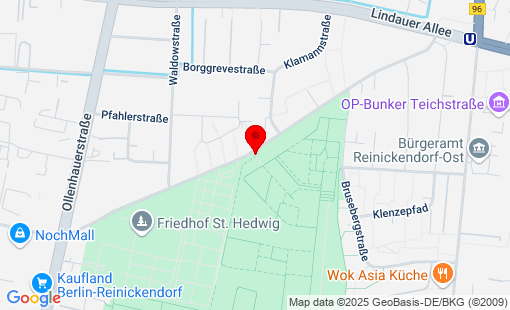Germany
Berlin-Reinickendorf, Friedhof Reinickendorf II
Total Occupation: 1.451 fatalities
Total Occupation: 1.451 fatalities
in 1886, the Reinickendorf community began to build a second cemetery, as the Reinickendorf cemetery opened in 1870 had already become too small. this new municipal cemetery was opened in 1890. The listed ceremonial hall by Carl Moritz dates back to 1897. After two extensions in the 1920s and 1960s, the cemetery is now the largest state-owned cemetery in Reinickendorf, covering an area of around 15.5 hectares. The Reinickendorf I cemetery was converted into a pure war cemetery in 1975; the last transfer took place in 2003. Since the deconsecration of the Reinickendorf I cemetery, the Reinickendorf II cemetery has also been referred to as the state-owned Reinickendorf cemetery (without numbering). Arthur Strousberg, the son of the "railroad king" and speculator Bethel Henry Strousberg, died of consumption in 1873 at the age of 23. The latter had his son buried in the family mausoleum in the Old St. Matthew's Churchyard in Schöneberg and commissioned Reinhold Begas to create a tomb. By the time the tomb was completed in 1874, Strousberg's financial situation was so strained that he was no longer able to pay the artist and had to pledge the mausoleum himself for a time. Strousberg was never to recover financially and died in 1884; his prestigious villa in Wilhelmstrasse became the British Embassy - the site of Sir Sebastian Wood's new British Embassy building since 1998. Begas, however, made a bronze cast of the tomb at his own expense and received a Grand Prix for it at the 1900 World Exhibition in Paris. After the artist's death in 1911, the city of Berlin acquired the work from his estate in 1913 and had it erected near the chapel of the Reinickendorf II cemetery. in 1928, Richard Ermisch erected an open-sided pillar hall to protect the work, which today serves as a memorial to the victims of the war.
Various personalities were buried in the Reinickendorf II cemetery:
- Otto Beyer (1885-1962), expressionist painter ostracized by the National Socialists - Klaus Brueske (1938-1962), casualty at the Berlin Wall - Fritz Hausberg (1880-1959), politician and town elder (honorary grave) - Meta Omanowsky (1902-1984), (grave of honor) - Hermann Schulz (1890-1942), resistance fighter against National Socialism - Olga Segler (1881-1961), one of the first and probably the oldest casualty at the Berlin Wall 15 victims of the First World War and more than 1.400 victims of the Second World War were buried there; two collective graves with an area of 230 m² were also used for this purpose. (Martin Bayer, 23.04.2020)
